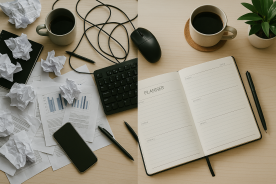The Myth We’ve Been Sold
For years, I have chased the elusive idea of work-life balance. I pictured it like a scale: work neatly on one side, family and self-care perfectly stacked on the other. If I could just distribute my time and energy correctly, I’d have it all together.
But reality? The scale never balanced. One demanding season at work, and suddenly something catches your attention. A child was sick at home, and deadlines loomed larger than ever. The harder I tried to balance, the more guilt and frustration I felt.

And here’s the truth: work-life balance doesn’t work.
Not because we’re not trying hard enough, but because the very metaphor is broken. Balance implies equality and stability — and life is rarely either. Instead, what we need is integration.
Why Balance Sets Us Up for Failure
Think of balance like walking a tightrope: one wrong step and everything crashes. That’s exactly how many professional women feel — one missed meeting or forgotten school pick-up and suddenly you’re “failing” somewhere.
But life isn’t static. Work demands shift, family needs change, and your own priorities evolve. Balance is rigid. Life is fluid. No wonder the two don’t fit.
What we really need is a framework that acknowledges the seasons of life, the ebbs and flows of energy, and the reality that sometimes work takes the front seat, and sometimes family or self-care does.
That’s where integration comes in.
From Balance to Integration
Integration is about designing your life so the different parts work together, instead of fighting each other.
Instead of aiming for “equal hours,” you ask: Does how I spend my time align with my values?
Instead of constant juggling, you create harmony between roles.
Instead of guilt over doing “too much here, not enough there,” you acknowledge that priorities shift — and that’s healthy.
“Integration feels like blending colors into a painting. Some days blue dominates, some days gold, but together they make a whole picture.”

I’d be lying if I claimed to have it all figured out — I don’t. I still need to remind myself of these truths every now and then. Over time, though, I’ve noticed that a sense of balance begins to feel more natural. With home deliveries now so accessible, I no longer have to spend evenings or weekends rushing through errands. Instead, those hours can be spent being present with my kids or pursuing other interests. The routine tasks can be delegated — unless it’s something we enjoy collecting together, which has become a weekly ritual.
I often remind my colleagues that work is never meant to be “finished” entirely; if it were, tomorrow would hold nothing to do. Unless it’s truly urgent, it can wait. As much as possible, I try to leave work at the office gate and consciously step into the next role in my life.
And here’s what I’ve learned: the world doesn’t fall apart. If, for any reason, I were unable to work for a few weeks, the world would keep turning — and my role would be replaced without hesitation. That realization freed me. It was the night I stopped chasing the illusion of balance and instead chose integration. I stopped striving for perfection and started aligning with what truly matters.
Practical Step: Audit Your Week for Energy vs. Expectation Mismatch
Here’s a simple tool to see where balance is failing you:
List your week’s activities. Everything counts — meetings, errands, childcare, workouts, Netflix.
Label each one:



Compare expectations vs. energy. Are you cramming in more 




This isn’t balance. It’s intentional integration.
Tools That Support Integration
When you’re designing for integration, small supportive tools can make a big difference. Here are a few to recommend:
Undated Weekly Planner with Habit Tracker — Perfect for planning weeks without the guilt of “missed days.” [Amazon link]
Desk Organizer with Charging Station — Keeps work clutter contained so your desk can transition from “work zone” to “life zone.”
Journaling Prompt
Take 10 quiet minutes and reflect:
- What part of my week feels most out of sync with my values right now?
- If I stopped chasing balance, what could integration look like for me this month?
Final Thought: From Overwhelm to Harmony
Balance demands perfection. Integration invites flexibility.
When we stop trying to hold everything in equal measure and instead ask, “How can these pieces work together?”, we free ourselves from guilt and unlock a more sustainable rhythm.
For professional women — especially those managing careers, families, and personal growth — work-life integration isn’t just a mindset shift. It’s a survival tool.
So next time you hear someone say “just find balance,” smile politely, and remember: you’re painting a masterpiece, not walking a tightrope.


